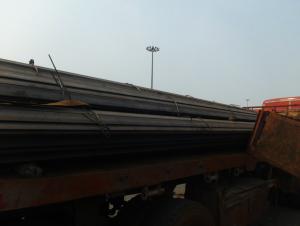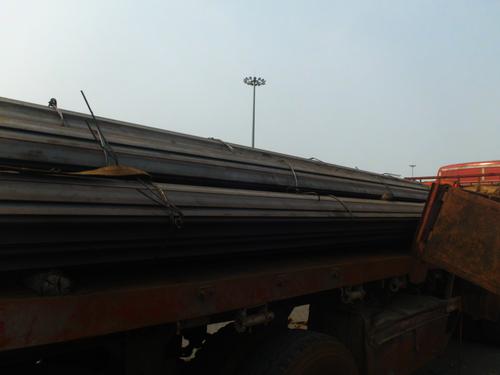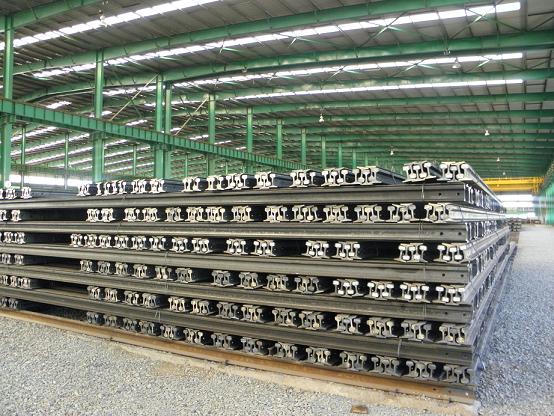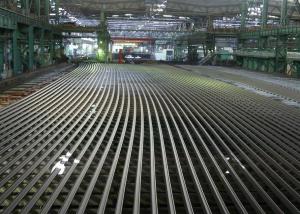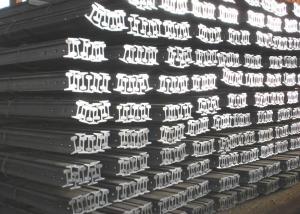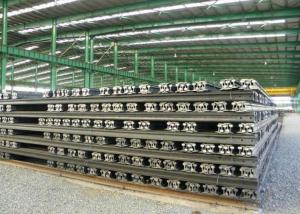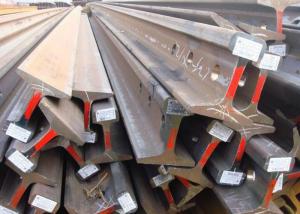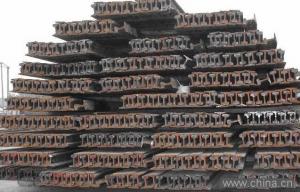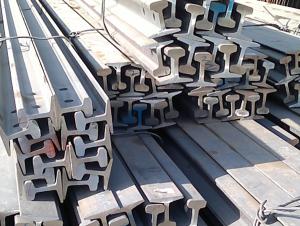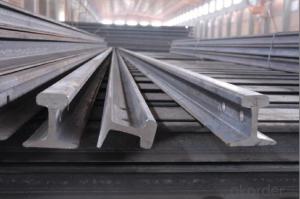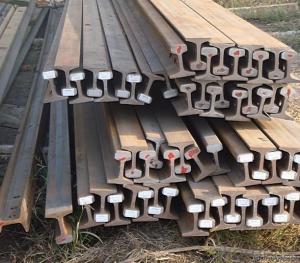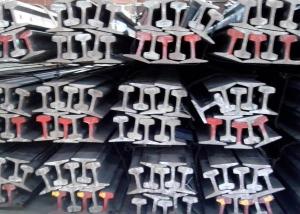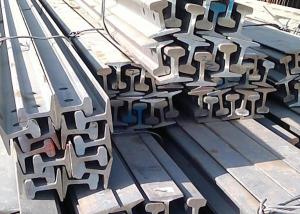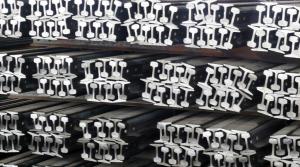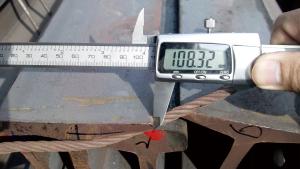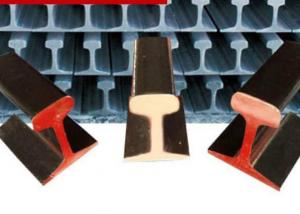Steel Light Rail GB 11264-89, DIN, AREMA, JIS, BS, UIC
- Loading Port:
- China main port
- Payment Terms:
- TT or LC
- Min Order Qty:
- 25 m.t.
- Supply Capability:
- 100000 m.t./month
OKorder Service Pledge
OKorder Financial Service
You Might Also Like
Product Description of Steel Light Rail GB 11264-89, DIN, AREMA, JIS, BS, UIC:
Alloy No | Grade | Element(%) | ||||
C
| Mn | S
| P
| Si
| ||
Q235 |
B
|
0.12—0.20 |
0.3—0.7 |
≤0.045 |
≤0.045
|
≤0.3
|
Invoicing on theoretical weight or actual weight as customer request
Payment terms: 30% advance payment by T/T, 70% payment against the copy of the B/L; 100% L/C at sight, etc.
Usages of Steel Light Rail GB 11264-89, DIN, AREMA, JIS, BS, UIC:
Light rail is mainly used in forest region, mines, factories and construction sites laid of the place such as temporary transport line and light motorcycles with line. Be widely used for railway, subway, transportation track, express, curve way, tunnel way and so on.
Packaging & Delivery of Steel Light Rail GB 11264-89, DIN, AREMA, JIS, BS, UIC:
1. Packing: it is nude packed in bundles by steel wire rod
2. Bundle weight: not more than 3.5MT for bulk vessel; less than 3 MT for container load
3. Marks:
Color marking: There will be color marking on both end of the bundle for the cargo delivered by bulk vessel. That makes it easily to distinguish at the destination port.
Tag mark: there will be tag mark tied up on the bundles. The information usually including supplier logo and name, product name, made in China, shipping marks and other information request by the customer.
If loading by container the marking is not needed, but we will prepare it as customer request.
4. Transportation: the goods are delivered by truck from mill to loading port, the maximum quantity can be loaded is around 40MTs by each truck. If the order quantity cannot reach the full truck loaded, the transportation cost per ton will be little higher than full load.
5. Delivered by container or bulk vessel
6. Delivery Time: All the Hot Rolled Steel Rail will be transpoted at the port of Tianjin, China within 30 days after receiving the advance payment by T/T or the orginal L/C at sight.
Inspection of Steel Light Rail GB 11264-89, DIN, AREMA, JIS, BS, UIC:
We will send the MTC of the factory to the clients dirrectly which contain the anlisis of the heat, chemiqul composition, phisical characteristicas, etc.
And our inspectors will arrive at the factory to meke the inspection of the size, length, weight and quantity before the transportation from the factory.
FAQ:
Q1: Why buy Materials & Equipment from OKorder.com?
A1: All products offered byOKorder.com are carefully selected from China's most reliable manufacturing enterprises. Through its ISO certifications, OKorder.com adheres to the highest standards and a commitment to supply chain safety and customer satisfaction.
Q2: How do we guarantee the quality of our products?
A2: We have established an advanced quality management system which conducts strict quality tests at every step, from raw materials to the final product. At the same time, we provide extensive follow-up service assurances as required.
Q3: How soon can we receive the product after purchase?
A3: Within three days of placing an order, we will begin production. The specific shipping date is dependent upon international and government factors, but is typically 7 to 10 workdays
Images:
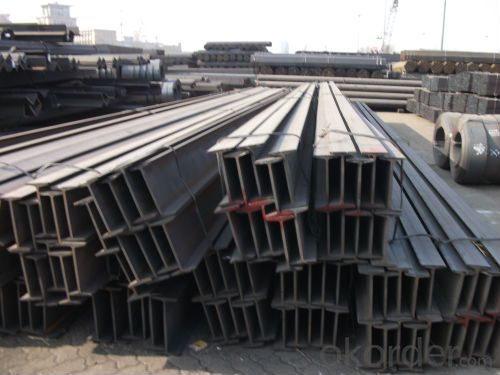

- Q: Are steel rails prone to warping or bending?
- Steel rails are generally not prone to warping or bending. Steel is known for its strength and durability, making it an excellent material for railway tracks. Steel rails are designed to withstand heavy loads and provide stability for trains, ensuring smooth and safe transportation. However, extreme temperature variations or improper maintenance can sometimes lead to minor warping or bending in steel rails. These issues can be addressed through regular inspections and maintenance to ensure the longevity and reliability of railway tracks. Overall, steel rails are highly resistant to warping or bending and are considered a reliable choice for railway infrastructure.
- Q: How do steel rails handle vibrations and shock?
- In order to ensure the safety and smooth operation of trains, steel rails have been specifically engineered to handle vibrations and shock. The exceptional material properties of steel, including its high strength and resilience, make it an ideal choice for constructing rail tracks. The inherent elasticity of steel rails allows them to absorb and dissipate vibrations and shock effectively. When a train travels over the rails, the steel is capable of flexing slightly to absorb the impact. This flexing action helps to evenly distribute the weight of the train along the rail, minimizing the impact on the track structure. Furthermore, wooden or concrete sleepers are commonly used to support steel rails, acting as a cushioning layer between the rails and the ground. These sleepers play a crucial role in dampening vibrations and shock by providing a buffer between the rigid steel rails and the track bed. To enhance the capacity of steel rails to handle vibrations and shock, regular inspections and maintenance are carried out. Any defects or damage, such as cracks or deformations, are promptly identified and repaired to ensure the integrity of the rail system. In conclusion, steel rails are designed to effectively handle vibrations and shock through their elasticity and the support of sleepers. Regular maintenance and inspections are essential to ensure the continued safe and efficient operation of rail systems.
- Q: What are the factors considered in determining the appropriate steel rail section for a railway line?
- The factors considered in determining the appropriate steel rail section for a railway line include the expected traffic load, train speed, axle load, track alignment, curvature, and gradient, as well as the environmental conditions such as temperature variations and corrosion resistance. Additionally, factors like the type of train operations, the desired lifespan of the rail, and the availability of maintenance resources are also taken into account.
- Q: How do steel rails contribute to track alignment?
- Steel rails play a crucial role in maintaining track alignment in the railway industry. The use of steel rails ensures that the tracks remain straight and in the correct position, enhancing the overall stability and safety of the rail system. Firstly, steel rails are manufactured with precision, allowing for consistent dimensions and accuracy. This uniformity in size and shape helps in maintaining the desired track alignment as it provides a stable and reliable foundation for the train wheels. The straightness of the steel rails ensures that the tracks remain parallel, preventing any deviation or misalignment. Furthermore, steel rails have high tensile strength, making them resistant to bending or warping under the weight and pressure exerted by passing trains. This strength allows for the rails to maintain their original shape and position, even when subjected to heavy loads or extreme weather conditions. By remaining straight and true, steel rails help in preventing any lateral movement or displacement of the tracks, which could lead to alignment issues. Additionally, steel rails are designed to be durable and long-lasting. They can withstand the constant friction and wear caused by train wheels, ensuring that the tracks remain stable and aligned over an extended period. The resilience of steel rails helps in minimizing any gradual deformation or distortion that could impact track alignment, thus ensuring a smooth and safe passage for trains. Moreover, steel rails are often equipped with various fastening systems, such as clips or resilient pads, which hold them securely in place. These fastening systems help maintain track alignment by preventing any lateral or vertical movement of the rails. They absorb vibrations and shocks caused by passing trains, minimizing the risk of track misalignment and ensuring a stable and safe rail infrastructure. In summary, steel rails contribute significantly to track alignment by providing a stable, straight, and durable foundation for the railway tracks. Their precision manufacturing, high tensile strength, durability, and fastening systems all work together to maintain the desired track alignment, enhancing the overall safety and efficiency of the rail system.
- Q: How are steel rails affected by ground settlement or shifting?
- Ground settlement or shifting has a significant impact on steel rails. The sinking or collapsing of the ground beneath the rails, known as ground settlement, and the lateral movement of the ground, referred to as ground shifting, both pose risks to the stability and integrity of the rails. When ground settlement occurs, it results in an uneven level beneath the rails. This unevenness creates stress concentrations on the rails, leading to increased wear and tear. Misalignment of the rails can also occur, causing a rough and bumpy ride for trains. Furthermore, settlement can create voids or depressions beneath the rails, further compromising their stability. On the other hand, ground shifting causes lateral movement beneath the steel rails. This movement can lead to rail misalignment and increase the risk of derailment. The lateral forces exerted by shifting ground can also cause the rails to buckle, resulting in significant damage and disruption to the railway system. To mitigate the impact of ground settlement or shifting on steel rails, various measures can be implemented. Regular monitoring of ground conditions is crucial, as is the implementation of proper drainage systems to prevent water accumulation. Stabilizing the ground using techniques such as soil reinforcement or ground improvement methods is also important. Additionally, proper maintenance and inspection of the rails are essential to detect any signs of settlement or shifting early on and take appropriate corrective actions. In conclusion, ground settlement or shifting has detrimental effects on steel rails. It is imperative to promptly monitor and address these issues to ensure the safety and efficiency of railway systems.
- Q: Can steel rails be used in high-speed rail networks?
- Yes, steel rails can be used in high-speed rail networks. Steel rails have been commonly used in traditional railway systems and can also withstand the high speeds and heavy loads associated with high-speed rail networks. They provide stability, durability, and a smooth surface for trains to travel on, making them a suitable choice for such networks.
- Q: What are the safety measures taken during steel rail repair?
- During steel rail repair, several safety measures are taken to ensure the well-being of the workers and the overall safety of the repair process. These measures include: 1. Personal Protective Equipment (PPE): All workers involved in the rail repair are required to wear appropriate PPE such as safety helmets, hi-vis clothing, protective eyewear, gloves, and steel-toed boots. This helps protect them from any potential hazards like falling objects, sharp edges, or chemical exposure. 2. Lockout/Tagout: Before commencing any repair work, the rail section is isolated from the power source and locked out, ensuring that no trains or other equipment can accidentally start moving during the repair process. This prevents any potential accidents or injuries caused by unexpected movement. 3. Fall Protection: Rail repair often requires working at heights, such as on elevated tracks or bridges. To prevent falls, workers are equipped with harnesses and safety lines, and guardrails or safety nets are installed where necessary. Strict adherence to fall protection protocols is crucial to preventing serious accidents. 4. Traffic Control: When performing rail repair near active tracks, proper traffic control measures must be implemented. This includes the use of warning signs, barriers, and flaggers to direct traffic and prevent unauthorized access to the work area. This helps protect both workers and passing trains from potential collisions. 5. Tool and Equipment Safety: Proper training is provided to workers on the safe handling and use of tools and equipment specific to rail repair. Regular inspections of tools and equipment are conducted to ensure they are in good working condition and pose no safety risks during the repair process. 6. Communication and Coordination: Effective communication and coordination among the repair team members are essential to ensure everyone's safety. Clear instructions, safety briefings, and regular updates on the progress of the repair work help prevent accidents and maintain a safe working environment. 7. Emergency Response: Despite all precautions, emergencies can still occur. Therefore, a well-defined emergency response plan is in place during rail repair. This plan includes ready access to first aid kits, fire extinguishers, emergency contact information, and evacuation procedures to promptly address any unforeseen incidents. By strictly adhering to these safety measures, the risk of accidents and injuries during steel rail repair is significantly minimized, ensuring the well-being of the workers and the successful completion of the repair work.
- Q: What are the advantages of using steel rails in port terminals?
- There are several advantages of using steel rails in port terminals. Firstly, steel rails provide a strong and durable foundation for heavy machinery such as cranes and forklifts, ensuring smooth and efficient movement of cargo. Secondly, steel rails allow for precise alignment and positioning of containers, reducing the risk of accidents and damage during loading and unloading processes. Additionally, steel rails offer excellent resistance to wear and tear, reducing maintenance costs and increasing the overall lifespan of the infrastructure. Lastly, steel rails enable efficient utilization of space in port terminals, as they can be easily configured and expanded to accommodate changing cargo volumes and requirements.
- Q: What are the different rail profiles used in steel rails?
- There are several different rail profiles used in steel rails, including the flat bottom (FB), bullhead (BH), vignole (V), and grooved rail profiles. Each profile has its own specific design and is used for different purposes in rail infrastructure.
- Q: How are steel rails affected by seismic dampening systems?
- Seismic dampening systems have a positive impact on steel rails as they are designed to mitigate the effects of earthquakes. These systems aim to decrease the magnitude of vibrations and ground movements caused by seismic activity. By minimizing ground shaking, seismic dampening systems safeguard the entire infrastructure, including steel rails. Steel rails experience significant stress during an earthquake due to ground movements. This stress can lead to rail displacement, bending, or even failure, disrupting train operations and posing safety hazards. However, seismic dampening systems can absorb and dissipate a substantial amount of seismic energy, thereby reducing the intensity of vibrations transmitted to the rails. The reduction in ground motion intensity achieved by seismic dampening systems helps to preserve the integrity of steel rails. This prevents excessive rail displacement or deformation, ensuring the continued functionality and safety of the railway system. Moreover, these systems also decrease the likelihood of rail buckling, which can occur as a result of thermal expansion during an earthquake. Furthermore, seismic dampening systems enhance the overall performance and durability of steel rails. By minimizing stress and fatigue, these systems extend the lifespan of the rails and reduce maintenance requirements. Consequently, railway operators can achieve cost savings, while the efficiency of the rail network is enhanced. In conclusion, seismic dampening systems are crucial for protecting steel rails during earthquakes. Their ability to reduce ground motion intensity helps maintain rail integrity, prevent displacement or failure, and improve overall performance and durability.
Send your message to us
Steel Light Rail GB 11264-89, DIN, AREMA, JIS, BS, UIC
- Loading Port:
- China main port
- Payment Terms:
- TT or LC
- Min Order Qty:
- 25 m.t.
- Supply Capability:
- 100000 m.t./month
OKorder Service Pledge
OKorder Financial Service
Similar products
Hot products
Hot Searches
Related keywords
